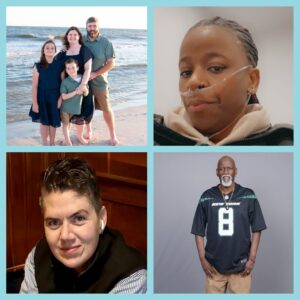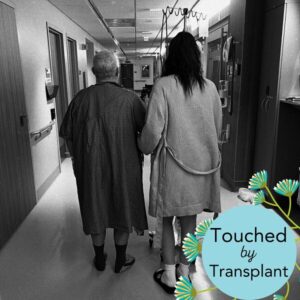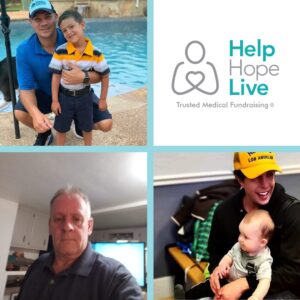In December 2014, Linda Jara was fighting off what she thought was a seasonal flu. After several visits with her doctor, Linda was diagnosed with heart failure. Medication couldn’t correct the issue, and as her condition declined, she received a left ventricular assist device (LVAD) as a bridge to a lifesaving heart transplant. In 2016, she finally got “the call” she had been waiting for.
I went from living a normal life to being in end-stage (advanced) heart failure within a month. This is how I was Touched by Transplant.
The Wait…and the Call
I waited for a heart for 18 months, from March 2015 to September 2016. My daily routine with an LVAD during that time: wake up; unplug from the wall unit; plug into the battery unit; record my numbers; take my morning medications; have breakfast; work out; shower and change my bandages every other day or use wipes; get dressed; go to work; come home; relax; go to bed; plug into the wall unit.

Linda waited for a heart for 18 months
The best way to describe waiting for a heart transplant is being on call 24 hours a day, 7 days a week. There is a momentary pang of anxiety every time the phone rings. You have no idea when the call will come. However, it can’t stop you from living your life. It is best to still make plans and live for the moment. You have to trust the process and know that waiting is part of making sure you will receive the best possible heart for you.

Linda explains LVADs to friends and supporters on social media
I had two false-alarm calls prior to “the one.” When I realized that call was THE call, it was surreal. I knew the minute I answered the phone that this call was different. This time around, the process from the phone call to surgery was a blur that happened within four hours. My emotions were mixed: I was happy, excited, sad, laughing, crying–you name it. My parents and a few close friends stayed with me until surgery started. That helped with the pre-transplant “will I survive?” anxiety.
Healing, Inside and Out
I was in the hospital for 23 days post-transplant. What I learned? Open heart surgery hurts. After the procedure, it hurts to lay in bed, to stand up, to cough, sneeze–you name it. This pain also affected post-surgery physical therapy, which became difficult because of fluid build-up in my body. But it’s essential to get in as much physical therapy after surgery as possible to heal well. That being said, I never looked forward to the therapist arriving!

Linda shows off her post-transplant scar
The most significant physical changes have been scars and scar tissue. Being just 6 months out from transplant, I have yet to feel great. I still tire easily, and I have to work on building up my endurance. Fortunately, I was sick for a very short time before I got my transplant, so I can still do most of the things I could do before the transplant.
Physically, I am enjoying life without being tethered to an LVAD. Freedom! I am working on improving my upper body strength and endurance so I can do even more. Emotionally, however, post-transplant life can be isolating. I have a few transplant friends who I can rely on to help me through the bad days. Despite how empathetic friends try to be, no one except other heart transplant recipients can understand the emotional challenges. There is a deep level of symbolism attached to the heart.

Linda uses her Help Hope Live campaign page to keep supporters updated
One of the biggest misconceptions about having a transplant is that your body is exactly as it used to be after you receive the new organ. Qualifying for a heart transplant was great, but it still isn’t as great as having your native heart. A new heart induces a significant adjustment period. I discovered how friends and family react to a medical crisis firsthand, and I identified people who could be a continued source of support. It was great knowing that there are at least some constants when your life is turned completely upside-down.

Friends provide ongoing support with a custom hashtag
Finding Support
I have the opportunity to discuss my emotional challenges with a transplant psychologist. Between her, my heart transplant friends and other members of my community, I am managing the best I can. Some days are difficult, but I have survived 100 percent of my worst days! As Emile Coue said, “Every day, in every way, I’m getting better and better.”

“Despite your empathy, you will never understand.”
The best thing to do for a loved one waiting for a transplant is to be supportive and understanding. What we are experiencing is something that, despite your empathy, you will never understand. People need to be mindful and make an effort to read our moods, but that doesn’t mean they have to walk on eggshells around us. Claiming that your cold or backache is “the worst thing in the world” sounds callous to someone waiting for a lifesaving (heart) transplant, especially because a heart transplant is one of the most complicated procedures out there.
Maintaining a New Heart
The transplant was not a cure. I have other medical conditions now that are not as serious as heart failure but are still significant. I developed prednisone-induced diabetes from post-transplant medications, but that condition should improve as my prednisone level decreases.

A transplant requires lifelong maintenance
In terms of maintenance, I need to take anti-rejection medications for the rest of my life as well as multiple other medications and supplements. I take 45 pills per day. I check my weight, temperature and blood pressure twice every day, and I check my blood sugar four times every day. It is my responsibility to notify my team if I am feeling off, notice a 2-pound weight gain, have a temperature of 99.5 degrees or higher or a blood pressure reading higher than 150/90. I have monthly right heart catheterizations and biopsies to check for rejection.
Exercise and a healthy lifestyle are also important. I take yoga classes and attend cardiac rehabilitation. I will be joining a cardiac rehab gym when this period of rehab is over.

“I take yoga classes and attend cardiac rehabilitation”
The Financial Side of Transplantation
I continue to fundraise with Help Hope Live post-transplant. I am on disability and fundraising helps to offset my monthly (out-of-pocket) medical expenses. Funds raised also helped to cover some of my mortgage payments when I was not receiving any income. A transplant is for life, and there will always be costs attached to this new lifestyle.
Help Hope Live helped me to get my fundraising efforts off the ground. The staff members that I have been fortune enough to meet are warm and make you feel like family. I remember laying in the hospital when the idea of fundraising was first presented to me. I was given the numbers for the cost of a transplant before insurance. The meds alone were over $60k (per year). I believe it is important to continue to fundraise so I won’t have to worry if unforeseen medical expenses pop up in the future.

Linda has no plans to stop fundraising post-transplant
A Lifelong Advocate
As a heart transplant recipient, I think it’s important to encourage people to register as organ donors. It would be difficult for someone to find a reason NOT to agree to donate if they were in the position to directly impact the life of someone they knew personally. It’s also hard to explain your choice not to be an organ donor to a living recipient like me!
 Linda fundraises for the Help Hope Live Mid-Atlantic Heart Transplant Fund. Follow her Blog for updates. Need help covering pre- or post-transplant expenses? Learn about starting a fundraising campaign with our nonprofit.
Linda fundraises for the Help Hope Live Mid-Atlantic Heart Transplant Fund. Follow her Blog for updates. Need help covering pre- or post-transplant expenses? Learn about starting a fundraising campaign with our nonprofit.
In December 2014, Linda Jara was fighting off what she thought was a seasonal flu. After several visits with her doctor, Linda was diagnosed with heart failure. Medication couldn’t correct the issue, and as her condition declined, she received a left ventricular assist device (LVAD) as a bridge to a lifesaving heart transplant. In 2016, she finally got “the call” she had been waiting for.
I went from living a normal life to being in end-stage (advanced) heart failure within a month. This is how I was Touched by Transplant.
The Wait…and the Call
I waited for a heart for 18 months, from March 2015 to September 2016. My daily routine with an LVAD during that time: wake up; unplug from the wall unit; plug into the battery unit; record my numbers; take my morning medications; have breakfast; work out; shower and change my bandages every other day or use wipes; get dressed; go to work; come home; relax; go to bed; plug into the wall unit.

The best way to describe waiting for a heart transplant is being on call 24 hours a day, 7 days a week. There is a momentary pang of anxiety every time the phone rings. You have no idea when the call will come. However, it can’t stop you from living your life. It is best to still make plans and live for the moment. You have to trust the process and know that waiting is part of making sure you will receive the best possible heart for you.

I had two false-alarm calls prior to “the one.” When I realized that call was THE call, it was surreal. I knew the minute I answered the phone that this call was different. This time around, the process from the phone call to surgery was a blur that happened within four hours. My emotions were mixed: I was happy, excited, sad, laughing, crying–you name it. My parents and a few close friends stayed with me until surgery started. That helped with the pre-transplant “will I survive?” anxiety.
Healing, Inside and Out
I was in the hospital for 23 days post-transplant. What I learned? Open heart surgery hurts. After the procedure, it hurts to lay in bed, to stand up, to cough, sneeze–you name it. This pain also affected post-surgery physical therapy, which became difficult because of fluid build-up in my body. But it’s essential to get in as much physical therapy after surgery as possible to heal well. That being said, I never looked forward to the therapist arriving!

The most significant physical changes have been scars and scar tissue. Being just 6 months out from transplant, I have yet to feel great. I still tire easily, and I have to work on building up my endurance. Fortunately, I was sick for a very short time before I got my transplant, so I can still do most of the things I could do before the transplant.
Physically, I am enjoying life without being tethered to an LVAD. Freedom! I am working on improving my upper body strength and endurance so I can do even more. Emotionally, however, post-transplant life can be isolating. I have a few transplant friends who I can rely on to help me through the bad days. Despite how empathetic friends try to be, no one except other heart transplant recipients can understand the emotional challenges. There is a deep level of symbolism attached to the heart.

One of the biggest misconceptions about having a transplant is that your body is exactly as it used to be after you receive the new organ. Qualifying for a heart transplant was great, but it still isn’t as great as having your native heart. A new heart induces a significant adjustment period. I discovered how friends and family react to a medical crisis firsthand, and I identified people who could be a continued source of support. It was great knowing that there are at least some constants when your life is turned completely upside-down.

Finding Support
I have the opportunity to discuss my emotional challenges with a transplant psychologist. Between her, my heart transplant friends and other members of my community, I am managing the best I can. Some days are difficult, but I have survived 100 percent of my worst days! As Emile Coue said, “Every day, in every way, I’m getting better and better.”

The best thing to do for a loved one waiting for a transplant is to be supportive and understanding. What we are experiencing is something that, despite your empathy, you will never understand. People need to be mindful and make an effort to read our moods, but that doesn’t mean they have to walk on eggshells around us. Claiming that your cold or backache is “the worst thing in the world” sounds callous to someone waiting for a lifesaving (heart) transplant, especially because a heart transplant is one of the most complicated procedures out there.
Maintaining a New Heart
The transplant was not a cure. I have other medical conditions now that are not as serious as heart failure but are still significant. I developed prednisone-induced diabetes from post-transplant medications, but that condition should improve as my prednisone level decreases.

In terms of maintenance, I need to take anti-rejection medications for the rest of my life as well as multiple other medications and supplements. I take 45 pills per day. I check my weight, temperature and blood pressure twice every day, and I check my blood sugar four times every day. It is my responsibility to notify my team if I am feeling off, notice a 2-pound weight gain, have a temperature of 99.5 degrees or higher or a blood pressure reading higher than 150/90. I have monthly right heart catheterizations and biopsies to check for rejection.
Exercise and a healthy lifestyle are also important. I take yoga classes and attend cardiac rehabilitation. I will be joining a cardiac rehab gym when this period of rehab is over.

The Financial Side of Transplantation
I continue to fundraise with Help Hope Live post-transplant. I am on disability and fundraising helps to offset my monthly (out-of-pocket) medical expenses. Funds raised also helped to cover some of my mortgage payments when I was not receiving any income. A transplant is for life, and there will always be costs attached to this new lifestyle.
Help Hope Live helped me to get my fundraising efforts off the ground. The staff members that I have been fortune enough to meet are warm and make you feel like family. I remember laying in the hospital when the idea of fundraising was first presented to me. I was given the numbers for the cost of a transplant before insurance. The meds alone were over $60k (per year). I believe it is important to continue to fundraise so I won’t have to worry if unforeseen medical expenses pop up in the future.

A Lifelong Advocate
As a heart transplant recipient, I think it’s important to encourage people to register as organ donors. It would be difficult for someone to find a reason NOT to agree to donate if they were in the position to directly impact the life of someone they knew personally. It’s also hard to explain your choice not to be an organ donor to a living recipient like me!
 Linda fundraises for the Help Hope Live Mid-Atlantic Heart Transplant Fund. Follow her Blog for updates. Need help covering pre- or post-transplant expenses? Learn about starting a fundraising campaign with our nonprofit.
Linda fundraises for the Help Hope Live Mid-Atlantic Heart Transplant Fund. Follow her Blog for updates. Need help covering pre- or post-transplant expenses? Learn about starting a fundraising campaign with our nonprofit.












